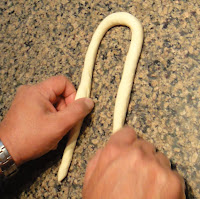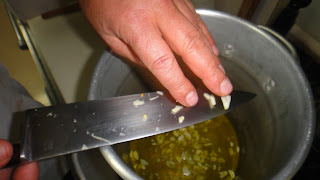Cavatelli pasta is a funny little caterpillar shaped noodle that is great with quick, fresh sauces. My son Mike gave me a cavetelli maker for Christmas and I really enjoy the way it churns out these little gems.
I made the cavatelli two ways, with cherry tomatoes and ricotta cheese and another dish made with hot Italian sausage and a browned butter sage sauce, both were were great tasting.
Cavatelli pasta recipe... serves 4
1 cup flour
1/2 cup water
1/2 teaspoon salt
1/2 cup ricotta cheese
Pile the flour right on your clean counter. Form a well in the flour, add the ricotta then the water and salt. Carefully stir with a fork, slowly incorporating the flour a little at a time until the mixture is formed into a dough. If the mixture is too sticky to handle you may need additional flour.
Knead the dough until it is pliable and springs back when you press it with your finger.
Form the dough into a rectangle one inch wide and a quarter inch thick, feed through the machine that is clamped to your kitchen counter or table. If you don't have a machine you can form the cavetelli by rolling into skinny ropes and cutting one inch long pieces, at this point you could use your fingers to press them into shape or use a flat tool to drag them into shape. To make the pasta by hand roll the dough out into a flat disk cut a strip and roll it into a rope, while you work with one, cover the rest with a clean, cloth kitchen towel...
Buying a cavatelli machine is probably the faster way to go...
Cook the pasta until it is past the al dente point, these little guys should be soft enough to readily absorb the flavors of your sauce. I found that if they are cooked to al dente there are some that undercooked in the batch. At least in the batches I have made.
I made a quick sauce with cherry tomatoes, garlic, olive oil, ricotta cheese and fresh herbs. It was light and tasty. The cavatelli soak up the sauce and, of course, you'll want to add a bit of grated Pecorino Romano.
The other dish I made was even better...
This recipe is from The Frankies Spuntino Kitchen Companion and Cooking Manual, which is a book that I highly recommend.
Cavatelli with Sausage and Sage Browned Butter
Ingredients:
1 pound hot Italian pork sausage (4 to 6 links depending on the size of the sausage)
7 tablespoons unsalted butter
8-10 sage leaves
freshly ground white pepper
ricotta cavatelli (double the recipe above)
1 cup grated Pecorino Romano
½ cup flat-leaf parsley leaves, coarsely chopped
7 tablespoons unsalted butter
8-10 sage leaves
freshly ground white pepper
ricotta cavatelli (double the recipe above)
1 cup grated Pecorino Romano
½ cup flat-leaf parsley leaves, coarsely chopped
Directions:
Put a large pot of water on to boil and salt it well.
Meanwhile, put the sausage into your widest saute pan with ½ of water and turn the heat to medium. After 10 minutes, flip the sausages over and simmer the for another 5 minutes (replenish the water if it threatens to boil off). After 15 minutes, the sausages should be firm and cooked through. Remove the sausages to a cutting board (discard the water) and slice them into coins just shy of ½ inch. (You can do this an hour or even a day ahead of time if you like.)
Add 1 tablespoon of the butter to the pan and turn the heat to medium-high. After a minute, add the sausage coins in an even layer and let them cook, untouched, unstirred, unfussed with, until they’re deeply browned on the first side. (If there’s not enough room to brown all the sausage in one pan — which there will very probably not be — split it between two pans or brown it in two batches and use as additional tablespoon of butter.) Flip and brown them on the B side. The browning is integral to the ultimate depth of flavor of the finished dish — don’t stint on it. When the sausage is browned, remove it from the pan (a plate lined with paper towels is a nice place to hold it) and return the pan to the burner.
Keep the heat at medium-high and add the sage, the remaining 6 tablespoons of butter, and a few twists of white pepper. Stire the butter and scrape the browned bits on the bottom of the pan with a wooden spoon. After a minute or two, it should stop foaming and start to take on color.
That’s when you should drop the ricotta cavatelli into the boiling water. Continue to cook the butter until it’s deeply browned and fragrant, about 4 minutes more, which should be just about how long the cavatelli takes to cook.
Do not drain the cavatelli too thoroughly. The water clinging to the pasta will give the sauce body. Add it to the butter sauce along with the sausage and stir.
Add the cheese, stir again, and portion the cavatelli among several serving plates. Scatter each with a couple of pinches of parsley. Serve immediately.
 |
| Mike gives the Cavetelli a taste test. |

























































